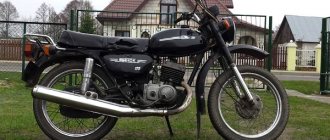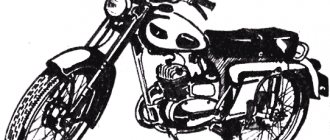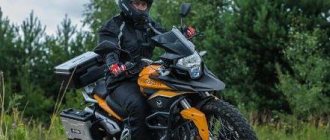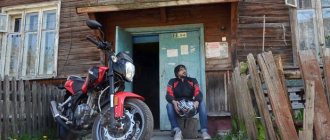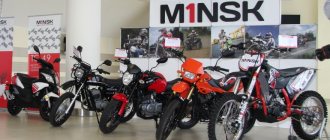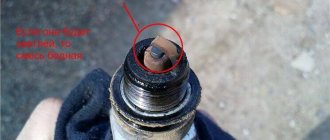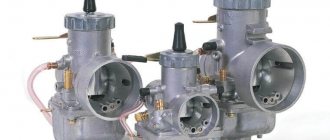— Sometimes the engine overheats in hot weather.
Main settings
The engine of the Yamaha EBR 125 is four-stroke, air-cooled, the number of cylinders is 1. Volume - 124 cubic meters. cm, power - 10 l. s., torque - 9.6 Nm at 6000-7800 rpm.
The maximum speed of the ebrik is 110 km/h. The first gear allows you to accelerate to 30 km/h, and then shift every 10-20 km. The gears are quite short and you have to switch them quite often to gain good speed. By the way, the motorcycle has 5 gears.
The approximate fuel consumption per 100 km for this motorcycle is about 3 liters. The fuel tank holds 13 liters of gasoline.
The Yamaha YBR 125 motorcycle has a front tire of 2.75-18 42P and a rear tire of 90/90-18 M/C 57P. Tire pressure with a load of up to 90 kg (i.e. only the driver) is 175 kPa and 196 kPa, and when driving with a passenger it should be 196 and 245 kPa on the front and rear wheels, respectively.
If we take the dimensions, the motorcycle has a mass of 117 kg, a saddle height of 780 cm, and a total length of almost 2 meters.
The estimated cost in Russia is from 60,000 to 170,000 rubles, depending on the condition of the motorcycle.
Specifications
Some technical characteristics of the Yamaha YBR 125 vary slightly depending on the year of manufacture, but on average they are as follows:
Engine
| Number of cycles | 4 |
| Number of cylinders | 1 |
| Number of valves per cylinder | 2 |
| Working volume | 124 cm³ |
| Bore and stroke | 54×54 mm |
| Maximum power | 10 l. With. at 7800 rpm |
| Maximum torque | 9.6 N•m at 6000 rpm |
| Intake type | Carburetor |
| Cooling system | Air |
| Starting system | Electric starter, kick starter |
| Transmission | |
| Gearbox type | Mechanical |
| Number of gears | 5 |
| Clutch | Multi-disc, oil bath |
| main gear | Chain |
| Dimensions and weight | |
| Length | 1985 mm |
| Width | 745 mm |
| Height | 1080 mm |
| Seat height | 780 mm |
| Wheelbase | 1290 mm |
| Ground clearance | 160 mm |
| Curb weight | 125 kg |
| Fuel tank capacity | 13 l |
| Chassis and brakes | |
| Frame | Steel diamond-shaped |
| Suspension | |
| Front | Telescopic fork |
| Front suspension travel | 120 mm |
| Rear | Pendulum with two shock absorbers |
| Rear suspension travel | 105 mm |
| Brakes | |
| Ahead | Disc hydraulic |
| Diameter | 245 mm |
| Behind | Drum |
| Diameter | 130 mm |
| Tires | |
| Ahead | 2.75-18 42P |
| Behind | 90/90-18 57P |
| Production | |
| Country of Origin | Japan |
Advantages of a motorcycle
Controllability
Ease of control of a motorcycle is a very important characteristic for novice bikers; the Yamaha EBR 125 has an excellent one, since it has low weight and power, as well as reliable brakes. It is convenient for maneuvering in city conditions, where there is not enough space on roads and in yards, and it also accelerates confidently. Many motorcycle schools use it as a training model; it is ideal for learning to drive and smoothes out all the mistakes that a beginner can make.
Reliability
The Yamaha YBR 125 is very simply designed, and you have to try really hard to break it. If the battery suddenly runs out, it starts easily with a pushrod or kick starter. In the event of a breakdown, even a novice motorbike enthusiast will be able to understand what exactly is broken thanks to the elementary design.
Economical
Considering the fuel consumption is 3 liters per 100 km and the gas tank volume is 13 liters, many owners of the Yamaha YBR 125 refuel once or twice a week. It turns out that a full tank is enough for 350-400 km.
It is economical in terms of oil consumption: the EBR 125 only needs to be filled with 1 liter of oil, whereas most motorcycles need to be filled with 2.5 - 3 liters.
As for the transport tax, it is much lower for small 125cc motorcycles than for larger ones.
Fuel consumption is 3 liters per 100 km, the volume of the gas tank is 13 liters. A full tank is enough for 350-400 km.
Patency
The Yamaha YBR 125 performs well on country roads and even off-road. Naturally, this is not an enduro and it will be problematic to overcome a mud pit, but it can handle the rest with ease. If necessary, you can install suitable tires on it and its cross-country ability will increase even more. However, keep in mind that you should not jump on an ebrike; the suspension is not designed for this kind of driving and may break.
Well, in case of big difficulties on the way, the YBR 125 can simply be carried by hand, since it weighs a little more than 100 kilograms.
Easy to repair
Spare parts for the Yamaha EBR 125 are very easy to obtain and are inexpensive. Therefore, in case of damage, you can always repair it without problems. And if you install protective bars on a motorcycle, then it will be almost impossible to cause any harm to it.
A common failure among beginners is damage to the plastic headlight fairing when falling to the side. In this case, it is recommended to simply replace the headlight with a round one. All parts for 125 cc bikes are quite cheap, and if you don’t fall or have an accident, you will be able to ride the Yamaha YBR 125 for a long time without repairs.
Liquidity
Since the start of production of Yamaha YBR motorcycles, they have been actively purchased in Russia, and therefore it will not be difficult to find this model for a small amount and in good condition. And when you outgrow this motorcycle, you can easily sell it.
Disadvantages of Yamaha YBR 125
Not cool enough
The Yamaha YBR 125 is by no means a super cool bike. This is an ordinary, simple motorcycle for beginners. Girls on the roads will not stare at you, and any nearby chopper or sportbike will easily outshine you. So just learn to ride without falling, and on the next motorcycle you’ll be able to show off.
Not comfortable on long trips
Ebrik is good when driving in the city, but when driving on the highway it becomes uncomfortable. Firstly, you won’t be able to accelerate faster than 110 kilometers, and secondly, you will probably be blown away by gusts of wind from passing cars, since the motorcycle is very light.
The optimal speed on the highway for this motorcycle is 90 km/h. And by the way, overtaking cars will be problematic, because the motorcycle accelerates very slowly at this speed.
The optimal speed on the highway for this motorcycle is 90 km/h.
A little history of the model
Since the introduction of Yamaha YBR 125 motorcycles, they have undergone many improvements and changes, becoming better and more reliable.
2004 – launch of sales of the first generation Yamaha YBR 125. In Russia, only versions with a trapezoid-shaped headlight and semi-fairing were sold. Features of this generation are:
- The wheels are three-spoke, tube tires.
- The gearbox pedal is short in length, which is inconvenient to use for people with large feet.
2007 - the second generation motorcycles were launched on sale, which did not change much in appearance, but they changed technically:
- The carburetor was improved, so that idle speed was easier to regulate.
- The gearbox pedal has been lengthened.
- Swapped out the dark gray color for light gray and the stickers on the plastic.
2008 - the modified third generation Yamaha EBR 125 went on sale, this time the motorcycle is already noticeably different from its predecessors. It had the following features:
- The wheels are five-spoke, tubeless tires.
- Heated carburetor.
- Chainring with mounting holes located in different locations, but the same size as before.
- On the rear fender, the location and method of attaching the turn signals has changed (attached using plastic clips). The turn signals themselves have become more streamlined and compact.
- The low beam began to turn on automatically when the ignition was turned on.
- A sensor for the side stand not being retracted appears on the panel.
- The brake pads, calipers, discs, front forks, mirrors and colors were also updated.
2010 - the company developed the fourth generation YBR 125 motorcycle. It has a significantly updated appearance, but these motorcycles are not supplied to Russia.
Similar models
Currently, there are quite a lot of small motorcycles in the 125 cc class on the market. The motors of other models are approximately similar in parameters, only the build quality differs. Many owner reviews and reviews show that the Yamaha EBR 125 is the most practical in its category.
However, if you want to save money, you can consider purchasing similar motorcycles, for example: Cobra Crossfire 125, Baltmotors S1 or Guowei GW125. Keep in mind that even a newly supported ebrik will be more reliable than any of these new motorcycles.
Which motorcycle should I take after the Yamaha EBR 125?
It is enough to skate one season on an ebrike to prepare for more serious equipment. Most likely, in the process of skating you will understand what is closer to you in spirit. However, you shouldn’t immediately switch to a heavy-duty bike; it’s better to opt for a motorcycle with a capacity of up to 1000 cc. cm. This will be enough for a full ride in any conditions, and you will be comfortable handling the new motorcycle.
If you like to ride fast and get off quickly, then you should choose a sportbike. If you like long trips, then you should pay attention to comfortable touring motorcycles. For those who like to ride off-road, enduro is suitable. And for relaxed trips around the city, a chopper would be an ideal option.
Everyone has their own tastes and lifestyle, but it’s still better to choose universal, simple models as your first motorcycle.
What is the tire size in Minsk
MOTORCYCLE TIRES MINSK M-106
The M-106 motorcycle is equipped with 65-484 (2.50-19) tires. The first numbers indicate the tire profile width and rim diameter in mm. The same dimensions in inches are indicated in brackets.
A tire consists of a tire, a tube and a rim tape that protects the tire from damage by the protruding ends of the spokes. Installing a tire without a connecting tape is not allowed.
Since the rear wheel tire operates in more difficult conditions than the front wheel tire, we recommend changing them once a season.
Rice. 22. Installation and dismantling of the tire.
1. Remove the wheel, bleed air from the chamber and place the wheel on a mat, board or other object to prevent sand from getting into the bearings. 2. Unscrew the nut securing the valve and push it inside the rim. 3. Squeeze the sides of the tire with your feet or a hammer so that the sides move away from the rim. 4. Use a mounting blade to pry the bead near the valve, pressing the bead into the recess of the rim from the opposite side (Fig. 22). 5. With the second spatula, pry the bead near the first at a distance of 10-15 cm and push the tire bead out first with the first and then with the second spatula. 6. Holding the part of the bead removed from the rim with one spatula, use the second spatula to remove the next section of the bead, etc. In this case, the part of the bead that has not been removed should be kept with your feet in the recess of the rim at all times. 7. Remove the tube and remove the second bead of the tire in the same way.
1. By inspection and feeling, check the condition of the inner surface of the tire, remove all foreign objects and sprinkle the inside of the tire and the outside of the tire with talcum powder. 2. Put on the rim tape, aligning the holes for the valve. 3. Place one bead onto the rim (using mounting blades). 4. After slightly inflating the tube, place it inside the tire, inserting the valve into the hole in the rim, and screw the nut a few turns. 5. Put on the second bead of the tire on the side opposite the valve, and pressing the tucked part with your feet, gradually fill the entire bead (Fig. 22). 6. Inflate the tube and, tapping along the entire perimeter of the tire, make sure that it sits evenly on the rim. 7. Inflate the tire to the required pressure, tighten the spool, nut and screw on the cap.
When mounting and dismounting a tire, extreme care must be taken to avoid damage to the tire, rim, and tube. The blades should not be inserted deeply into the tire, and when pressing on them, you must make sure that the tube does not get between the blade and the rim.
During installation, you must ensure that the tube fits evenly in the tire, without folds or pinches. If installed (dismounted) correctly, it does not require much effort, especially if you carefully press the tucked part of the tire with your feet. However, in cases of extreme necessity (very hard tire, lack of experience), to facilitate the work, you can lubricate the tire bead or mounting blades with soapy water.
With a certain skill, tire installation can also be done using a hammer, hitting the side of the tire with it.
Damaged parts of the tube, as well as tires, should be vulcanized. However, in extreme cases, such as when traveling, the camera can be repaired by applying a patch with glue.
To do this you need:
Please be aware that rubber cement patches may become loose from the camera in hot weather or when driving fast on asphalt. Therefore, the chamber must be repaired by vulcanization, and rubber cement must be used only for temporary repairs.
Source
Motorcycles of the Belarusian brand Minsk
At one time, the motorcycles of the Minsk holding stood out from the rest due to the high quality of components and the ability to travel in almost any conditions. Years after the release of the first model, the Minsk-based company still produces high-quality motorcycles, scooters, ATVs and snowmobiles.
History of creation and international success
Motorcycles from the Minsk company appeared on the market back in 1951. Over its 70-year history, the manufacturer has sold more than 7 million motorcycles in more than 50 countries.
The basic model is the M1A motorcycle. Modifications of this model have become widely known due to their versatility - the vehicle is suitable for both simple road driving and off-road use with an installed Enduro power unit.
After World War II, German in the USSR, or more precisely in Moscow. There the plant began producing the first motorcycle models under the M1A brand. In 1951, the production of this brand of motorcycle was transferred to the Minsk Motorcycle Plant.
A large number of Minsk motor vehicles were sent to Vietnam and other Asian countries. This was facilitated by the high quality of components, powerful technical performance and affordable price. Such success led to a worldwide calling, and engineers had to modify their own line. In Vietnam, they even organized a fan club for motorcycles, Minsk, which officially opened in 1988. It is noteworthy that the club annually celebrates motorcycle day, attracting an increasing number of members and fans of this equipment.
In 1991, the Minsk motorcycle received an update that brought its technical performance to almost its maximum. That year, the number of products produced reached 225 thousand every year.
In 1999, the vehicle received the prestigious international “European Arc” award, which once again emphasizes the value of the motorcycle outside the countries of the former Soviet Union. After that, the award-winning model was modified several times, which increased the demand for it in Europe.
Specifications
Technical indicators should be divided into two categories: external and internal.
External characteristics
The length of the motorcycle is 2.1 meters. The height is 1.2 meters with a distance between the axes of 1.32 meters. The size of the rudder line is 0.8 meters. The ground clearance is 12.5 cm.
The Minsk motorcycle reaches a maximum speed of 95 km per hour with a maximum permissible passenger weight of 165 kg.
Internal characteristics
The power unit of the Minsk motorcycle has always been unpretentious in operation, remaining extremely reliable even by modern standards.
The motorcycle engine is gasoline-based, with one cylinder, the diameter of which is 0.52 cm. The piston stroke is 0.58 cm with an engine displacement of 125 cc. see. Maximum engine power is 12 horsepower at 6.9 thousand rpm.
The motorcycle has always been distinguished by high-quality compression, the degree of which is 10.5. The motorcycle is powered by a K-62C carburetor with an air cooling system.
The motorcycle has a four-speed gearbox with a foot shift mechanism.
It is recommended to use 76 grade gasoline as fuel in a proportional ratio of 25 to 1 with engine oil. Fuel consumption averages 3.5 liters per 100 km.
The lineup
Now the plant in Minsk specializes in the production of three types of motorcycles:
- classic – C 125, C4 125, C4 200, D4 125, M 125 and M 125X;
- enduro (for off-road driving) – TRX 300i, X 200, ERX 250;
- street (sports motorcycle for city driving) – R 250, C4 250, CX 200.
At the moment, the most affordable and popular are the following Minsk motorcycle models:
All of these models have an engine capacity of 125 cubic centimeters to achieve the maximum balance of performance and efficiency.
Minsk S 125
This model is considered basic. The motorcycle is considered an SUV, so most Minsk motorcycles are produced on its basis. For off-road driving, the motorcycle is equipped with high-strength rubber, with which the warrior can reach speeds of up to 60 km per hour.
Engine with two strokes and one cylinder. This power unit is enough for a comfortable ride. Over 100 kilometers traveled, the motorcycle will “eat” 3 liters of gasoline. When traveling over rough terrain, this figure will increase to 4 liters.
The engine is started using a kickstarter. This system provides reliability in all weather conditions.
Many users mistake the C 125 for a moped. This is facilitated by its small dimensions and two-stroke engine.
Watch a video review of the Minsk S 125 motorcycle:
Minsk D4 125
The power unit is also with one cylinder, but with four strokes. The model belongs to the sports category. The number of revolutions that the motorcycle produces allows you to maintain high speed driving for a long period of time.
The maximum speed is 100 km per hour. For quick acceleration, a gearbox with five gears is installed. Gasoline consumption per 100 km of driving will be only 2.6 liters. A big plus is the presence of an electric starter.
The vehicle weight is 100 kg. Many drivers consider the presence of a welded footrest for passengers to be a disadvantage, because it cannot be removed.
Watch a video review of the Minsk D4 125 motorcycle:
Minsk M 125
M 125 is the most popular model in the company's line of motorcycles. This success is based on low maintenance. Many users say that the M 125 is simply impossible to kill.
The motorcycle has a single cylinder, two stroke engine. Fuel consumption is also minimal: over 100 kilometers traveled, the gas tank will be empty by 2.5 liters.
The standard version is equipped with drum brakes, which can be replaced with disc brakes. As an additional option, you can order a stroller for carrying cargo. Model weight – 122 kg.
Watch a video review of the Minsk M 125 motorcycle:
Price
Minsk motorcycles have always been available at an average price. At the moment, the average cost of a motorcycle is 75 thousand rubles, but modified versions can cost 150 thousand rubles.
Almost 70 years after the launch of production of the first motorcycles, the Minsk company continues to remain among the leaders in manufacturers of high-quality and inexpensive motorcycle equipment. At the moment, Minsk brand motorcycles are produced in three modifications.
Motorcycle tires Minsk D4 125 125 10 Hp
This page contains technical information about the motorcycle Minsk D4 125 125 10 Hp. Based on the characteristics of the wheel sizes, motorcycle tires produced by Petroshin were selected, which can be installed on the front and rear wheels, depending on the size. Among others, the following tire models are suitable for the Minsk D4 125 125 10 Hp motorcycle: L-251 S-109 L-251 S-109
Motorcycle Specifications
:
| Number of cylinders | 1 |
| Number of cycles | 4 |
| Number of gears | 5 |
| Number of carburetors | 1 |
| type of drive | Chain |
| Type | Classic |
| Dry weight | 100 kg |
| Supply system | Carburetor |
| Cooling system | Air |
| Front wheel size | 3.00-18 |
| Rear wheel size | 3.00-18 |
| Approximate fuel consumption per 100 km | 2.5 l |
| Full Width | 770 mm |
| Full Length | 2100 mm |
| Full Height | 1110 mm |
| Front brakes | Single disk |
| Gas tank volume | 12 l |
| Volume | 125 cm? |
| Power at rpm | 8000 min-1 |
| Power | 10.5 hp |
| Maximum speed | 100 km/h |
| Wheelbase | 1290 mm |
| Clearance | 210 mm |
| Rear brakes | Drums |
| Motor tire L-251 (3.00-18) 80/100-18 M/C 52L |
| Motor tire S-109 (3.00-18) 80/100-18 M/C 52L |
| Motor tire S-109 (☆ discount, production September 2022 ☆) (3.00-18) 80/100-18 M/C 52L |
| Motor tire L-251 (☆ discount, production September 2022 ☆) (3.00-18) 80/100-18 M/C 52L |
| Motor tire L-251 (3.00-18) 80/100-18 M/C 52L |
| Motor tire S-109 (3.00-18) 80/100-18 M/C 52L |
| Motor tire S-109 (☆ discount, production September 2022 ☆) (3.00-18) 80/100-18 M/C 52L |
| Motor tire L-251 (☆ discount, production September 2022 ☆) (3.00-18) 80/100-18 M/C 52L |
Other options for selecting motorcycle tires produced by Petroshin for motorcycles in the configurator
Source
contents .. 1 2 3 ..TECHNICAL CHARACTERISTICS OF THE MOTORCYCLE “MINSK” MMVZ 3.111
General data Motorcycle base - 1230-1275 mm Ground clearance at full load and normal tire pressure, not less than - 135 mm
Overall dimensions of the motorcycle: - length (without trunk) - 2100 mm - width (without mirror) - 660 mm - height (without mirror) - 1000 mm
Weight (dry) without trunk - 100 kg maximum Maximum load (including driver) - 150 kg
Maximum speed - .90 km/h Braking distance with two brakes when driving at a speed of 60 km/h - 25 m Average operating fuel consumption per 100 km when driving in various road conditions - 3.5-4.0 l
Engine Engine type - two-stroke Number of cylinders - 1 Cylinder diameter - 52 mm Piston stroke - 58 mm Compression ratio - 8.5 ±0.3 Cylinder displacement - 123 cm3 Maximum engine power at 5500-6000 rpm - 9.5 l /s Maximum torque - 1.15 kgm Lubrication system - a mixture of gasoline and oil Carburetor - K-36S Fuel and lubricant used - a mixture of A-72 gasoline and AKZp-10 oil Air filter - contact-oil Cooling - air
Power transmission Clutch - multi-plate in oil bath
Gearbox - 4-speed, two-way Gear shift - mechanical, foot
Gear ratio from the engine to the gearbox - 2.75 Transmission from the gearbox to the rear wheel - single-row roller chain PR 12.7-1800-2 GOST 10947-64 Gear ratio from the gearbox to the rear wheel - 2.67
General gear ratios of the gearbox: - in first gear - 2.924 - in second gear - 1.966 - in third gear - 1.331 - in fourth gear - 1.000
Total gear ratios from the engine to the rear wheel: - in first gear - 21.469 - in second gear - 14.435 - in third gear - 9.773 - in fourth gear - 7.342
Chassis Frame - tubular, closed type Front fork - telescopic Rear wheel suspension - lever Wheels - not interchangeable Brakes - shoe shoes with a diameter of 125 mm Tire size - 65-484 mm (2.50-19″) or 80-459 mm (3. 00-18″)
Electrical equipment Source of electricity - alternating current generator G-421 High-voltage transformer - B-302 Switch - P-200 Sound signal - S-34 Headlight - FG-133 Rear lamp - FP-246 Central motorcycle switch Throttle - DR100 Capacitor - MBM 0.1 mkf, 160 V. Turn signal breaker - RS-421 Turn signal - UP-208 or FUP2 Switch - P-201 Brake light switch - VK-854 Speedometer - SP-131 Spark plug - A6BS
Refueling tanks Fuel tank - 12 l Gearbox housing - 0.500 l Front fork blade - 0.150 l Rear suspension shock absorber - 0.050 l Air cleaner housing - 0.050 l
Basic data for adjustment and control Ignition timing to TDC - 3.2-3.7 mm Gap between breaker contacts - 0.35-0.40 mm Gap between spark plug electrodes - 0.6-0.7 mm Clutch lever free play - 5-10 mm Free play of the hand brake lever - 5-10 mm Free play of the foot brake lever - 10-15 mm Free play of the throttle cable - 1-2 mm Free oscillation of the chain - 15-20 mm
Tire pressure: front - 1.5 atm rear (without passenger) - 1.7 atm rear (with passenger) - 2.0 atm
contents .. 1 2 3 ..
Motorcycle tires for M1NSK X250
Choosing a motorcycle tire
The Chinese have their own Chinese sizes, namely: before 3.00-21; rear 4.60-18
After reading specialized literature and talking with knowledgeable people, suitable European sizes were determined: before 90/90-21; rear 120/90-18
Having determined the required size, I decided to puzzle myself with the choice of suitable tires, to my surprise, the offer on this market is unrealistically huge, one manufacturer has up to 40 models of the same tires for cross-country and enduro, ranging from sand to stones and rocks
I’ll skip the agony of choice, doubt and other lyrics.
In the end I chose tires:
Before Mitas C-02 120/90-18 [71N TT]
Rear Mitas C-21 90/90-21 [54R TT]
Tire installation
To remove the wheels, you need to remove the calipers; to do this, unscrew 2 bolts on each axle; secure or hook the calipers so that they do not interfere
Next, remove the wheels; for convenience, lay the motorcycle down; I used a hydraulic jack.
We unscrew two nuts on each of the axles and knock out the central rod, there is a speed sensor in front, be careful. We take out the chain tensioners from the rear and release the chain. As a result, we remove both wheels.
Tire service
To be more efficient, I went to the nearest tire repair shop. As soon as the guys saw the wheels, they immediately said: “no, it’s difficult, we won’t do it.” Okay, I went to the next one, where everything was done quickly and efficiently for 15 minutes.
Installation
Everything is assembled in the reverse order, additionally lubricate everything with grease. Please also note that I have the star set to 15. The wheel is 0.8-1 cm further than the standard one. This prevents it from rubbing against the pendulum. When installing, take this fact into account; with a 17th standard star, this distance will be 0.2-0.4 cm.
We set the middle, everything fits perfectly
I took it for a ride, and I want to say this is space, there are no words, it holds the road like a glove. Sand? What is this? Rowing with a bang! Speeds for the same routes have doubled or tripled.
It immediately becomes clear what Enduro and cross tires are.
Source
Technical indicators
Judging by the reviews of its owners, the Minsk m 125 has good quality indicators, which should be noted:
| Dimensions (length; width; height) | 210; 77; 123 cm |
| Weight (dry) | 120 kg |
| Speed | 90 km/h maximum |
| Fuel tank volume | 11 l. |
| Engine | 2-stroke 1-cylinder air-cooled |
| Fuel consumption | 3.7 l/100 km |
| Engine capacity | 125 cc cm |
| Start | Kickstarter |
| Engine power | 10.5 l. With. at 5900 rpm |
| Brake system | Drum |
| Suspensions (front; rear) | Telescopic fork; pendulum with 2 shock absorbers |
Thanks to its standard dimensions and low weight, the motorcycle is very simple and easy to operate even for people of short stature. The impressive volume of the fuel tank and low fuel consumption (about 3 liters on a combined cycle) allow you to drive for a long time without refueling. The powerful single-cylinder engine is capable of reaching speeds of up to 90 km/h, although 60-70 km/h are optimal.
Anyone, even a novice driver, will be able to calmly and, most importantly, safely move around the city or on the highway. The motorcycle is ideal for learning or honing control skills, as it is equipped with reliable drum brakes and soft suspension.
